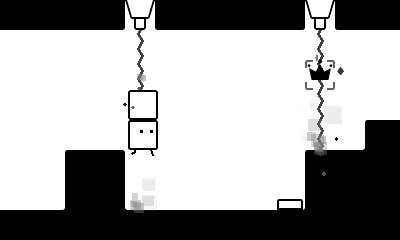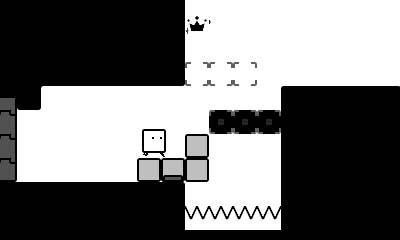Box Boy 3DS Review: It's Hip to be Square
HAL Laboratory puts an unexpectedly fresh spin on block-based puzzles in this quirky 3DS eShop release.
This article first appeared on USgamer, a partner publication of VG247. Some content, such as this article, has been migrated to VG247 for posterity after USgamer's closure - but it has not been edited or further vetted by the VG247 team.
In the world of video games, block-pushing puzzles mostly act as filler; an easy way to drop in some "thinky bits" without forcing developers to work too hard.
Over the past few years, though, Nintendo platforms have done much to restore the reputation of block-pushers. Intelligent Systems' Pushmo, Crashmo, and Pushmo World honestly gave me a new appreciation for these kinds of puzzles thanks to their smart design and user-friendly features—like the ability to quickly rewind if you screw up a move. HAL Laboratory's Box Boy stems from this same school of thought, and its attempt to rethink block-pushing provides challenges on a much smaller scale than what's found in the Pushmo family of games—making it an even better fit for the handheld format.

Box Boy builds its collection of minute-long puzzles around the strange abilities of protagonist Qbby; instead of finding boxes throughout the levels—like your common Lolos and Lalas—this anthropomorphized square generates them from his own body in a manner that doesn't look entirely comfortable. Since each level places a cap on the amount of boxes Qbby can generate at once—starting a new formation merely blips the previous one out of existence—the real challenge comes from working within these limitations to reach the goal at the end.
It's a premise that, at first, feels a little too basic; by the end of the first set of challenges, I was asking myself, "How are they going to get a whole game out of this?" But, with each grouping of levels, HAL manages to find surprising new uses for Qbby's powers. While you'll initially be spawning blocks to bridge gaps and cover spikes, soon enough, Qbby will be using his box-growing ability to grab onto ledges and pull himself up, snake his way through tunnels, and build makeshift helmets and shields to protect himself from dangerous lasers. He's a surprisingly versatile little rhombus.
And when Box Boy finally mines the extent of Qbby's powers, the levels themselves begin to incorporate new elements, forcing you to rethink how to to use his abilities in different contexts. Once you've learned the basics, each grouping of levels centers around a new environmental element, and, in true Nintendo fashion, these challenges subtly teach in order to prepare you for the final test. These additions add just the right amount of complication to Box Boy while keeping the laser focus of its game play intact; whether you're being carried around by massive cranes, diving through portals, or filling gaps to break rows of geometry, Tetris-style, the essential actions of Qbby himself never change.

Even though Box Boy offers some pretty tricky levels, it still manages to be intensely friendly without compromising the challenge. The levels are short, but offer frequent checkpoints, meaning you're only asked to process one or two steps at a time; an improvement on games like Pushmo, which would often have me wondering exactly when I messed up a move in one of its massive puzzles. And finally we have a Nintendo-published puzzle game that makes instantly restarting a level completely painless; just hit L and R and you'll zip right back to the beginning of the stage—something I desperately wish they'd patch into Captain Toad.
In general, HAL's approach with Box Boy cuts out much of the frustration you'll find in other block-based puzzle games, as it lets players rapidly prototype possible solutions without first having to start over from square one. Honestly, this helped me soldier on through puzzles that would've left me stymied in similar games, and I'm hoping other developers take notice.
Like most eShop releases, Box Boy didn't get the biggest push from Nintendo—someone had to remind me it was actually out—and I can see many people shying away from this strange new IP with barebones graphics—heck, it doesn't even use the system's 3D feature. But, for the price of a fancy latte, Box Boy comes loaded with a ton of great puzzles, and delivers them in a way that won't test your patience. I'm not sure if there's enough ideas left to make for a worthwhile sequel, but it's always refreshing to see mega-developers like HAL take a break from their cash cows for neat little diversions like Box Boy. If you'd like to see more fun experiments of this sort, vote with your dollars—this time around, you'll only need five of them.
VisualsBox Boy's intentionally lo-fi style gives it a distinct look, and does an excellent job of communicating the essential visual information of its many levels.
SoundThe music feels largely ambient, and fits well with the action. Though it often fades into the background, thankfully, it never distracts.
InterfaceIt's as basic as you can get, which works extremely well with Box Boy's minimalist vibe.
Lasting AppealBox Boy offers plenty of levels, and each one contains a number of collectible crowns that can only be nabbed by players making the most efficient use of Qbby's abilities. And there's a handful of time and collecting-based bonus levels if you still need more Box Boy in your life.
ConclusionIf you crave a digestible and portable puzzle-based diversion, look no further than HAL's Box Boy. Its outright friendliness helps combat the patience-testing nature of most puzzle games, and those minutes-long levels allow players to make some degree of progress, even if they don't have much time to spare. Box Boy might not change the world, but even so, it's refreshing to see a big developer like HAL take a gamble on such a quirky little experiment.
